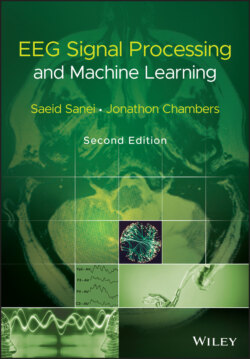Читать книгу EEG Signal Processing and Machine Learning - Saeid Sanei - Страница 25
2.2.3 Invasive Recording of Brain Potentials
ОглавлениеInvasive brain screening is mainly to get closer to the neurons and thereby gain information about timing of neuron firing and the exact locations of defected neurons (such as for seizure) for various purposes such as deep brain stimulation, surgical operation, or rehabilitative implants.
The recording directly from over the cortex, called electrocorticography (ECoG), or intracranial electroencephalography (iEEG), is a type of electrophysiological brain monitoring that uses a grid of electrodes placed directly on the exposed surface of the brain to record electrical activity from the cerebral cortex. Figure 2.7 shows an example.
A popular application of ECoG is the localization of the central sulcus by means of phase reversal of somatosensory evoked potentials (EPs) for BCI‐based rehabilitation.
Another technique for iEEG recording is by using strings of electrodes inserted into foramen ovale holes (Figure 2.8) deep into the hippocampus mainly to record the neuron activities during seizure and localization of infected neurons for surgical purposes. A set of these electrodes can be seen in Figure 2.9.
Later in Chapter 11 of this book we will show the application of this recording modality in detection of interictal epileptiform discharges (IEDs) from the hippocampus.
With the advances in microelectronics and microsensor designs, a new type of microsensor array insertable into the brain blood vessels within the motor cortex without any open surgery has been designed. The sensor array, called Stentrode™ is a small metallic mesh tube (stent), with not more than 4 mm diameter and with electrode contacts (small metal discs) within the stent structure.
The Stentrode™ (Figure 2.10) is expected to accurately record the neuronal activities within motor area and therefore help patients with loss of motor function due to paralysis from spinal cord injury, motor neuron disease, stroke, muscular dystrophy, or loss of limbs.
Figure 2.7 Electrocorticography.
Figure 2.8 Foramen ovale holes within facial skeleton.
Figure 2.9 Foramen ovale electrodes.
